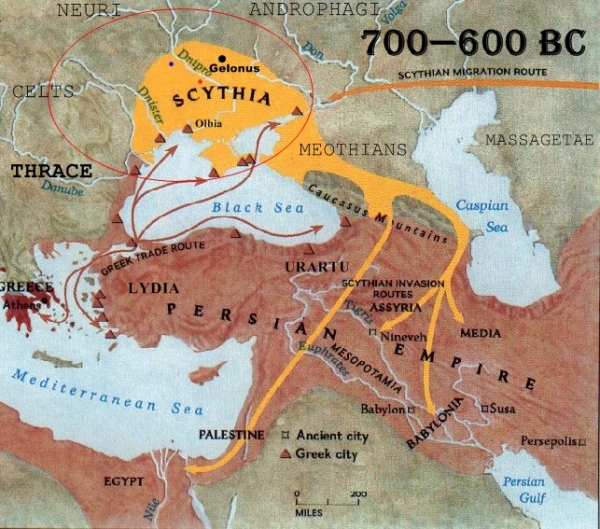 |
Were the Scythians Israelites?
|
The Scythians migrated all the way from Palestine to the Crimea, then to Germany, and ultimately to England and Scotland. "For lo, I will command, and I will sift the House of Israel among ALL the NATIONS, like as corn is sifted in a sieve, yet shall not the least grain fall upon the earth" (Amos 9:9). |
by HOIM Staff
When Jacob built shelters for his cattle in Jordan, he called the place Succoth [1], which in Hebrew means cottages or huts. When Israel dwelt in Egypt, she named a town Succoth [2]. In Palestine, the city of Succoth was given to the tribe of Gad [3].
The booth or tent was the home of a wandering people. (Today we still have words that mean "Wander" such as scoot, scat, scout and skate.) These wandering people called themselves Scoloti, but the Greeks called them Scythians, Scuthai or Nomades [4]. A medieval Jewish writer says one branch of the Israelites "evaded the calamity (of an Assyrian captivity), going off with their flocks and turning nomads, and that the chief or prince whom they appointed could muster 120,000 horse and 100,000 foot [5]."
These numbers agree with the apparently large Israeli army in 2 Chronicles 28:5-8, and Israel's small population a few years later in 2 Kings 17:24-31 is supported by only 27,290 Israelites being taken captive [6]. Later they moved north to the Black Sea area which they called Scythia. They were descended from slaves [7], and according to Jordanes, the Scythians are tall, have blue eyes and blonde hair [8].
Israel was deported to Media [9] which is the same place that Diodorus Siculus says the Scythians had their origin on the Araxes River [10]. Herodotus then says the Scythians moved across the Araxes into Cimmeria (the Crimea) [11]. In 2 Esdras 13:40-46 we read that Israelites traveled this same route.
Herodotus defines Scythia as being on the north coast of the Black Sea, from the mouth of the Danube to the Palus Meotus; on the east, to the Don or Tanais, to its rise out of the Lake Ivan; on the north, a line drawn from this lake to that out of which the Tyras or Dniester flows; and on the west, a line from thence to the Danube [12]. Later, Germany was known as Scythia [13].
 |
In ancient times Scandinavia was called SCATHAnavia. Ireland was known as SCOTIA Major and Scotland was called SCOTIA Minor (Venerable Bede and Nennius).
Strabo says, "All the nations toward the northern parts, the ancient Greek writers call Scythians [14]." According to the Encyclopaedia Britannica, "Most writers think the Scythians who troubled Asia were Sacae from the east of the Caspian [15]." Herodotus says, "SACAE is the name the Persians give to all Scythian tribes [16]."
The Caspian area is where Assyrians had settled the ten tribes of Israel whom they had taken captive [17]. The Israelites were named after Isaac [18] -- from which the name SACAE is derived. That name then became Saxon (son of Isaac). These Saxon people migrated to northern Germany (Saxony) and southeast England (Sussex, Essex and Middlesex).
Are The SCOTS From SCYTHIA?
Another branch of the Israelites was taken captive to Assyria and Media [19] and "to the river Gozan [20]." Ptolemy mentions the Ascitae of Arabia [21] and the Ascotancae east of the Caspian [22]. As Diodorus Siculus says, these Scythians were "of mean origin on the Araxes (Araks today) [23]." This is the same place Israelite captives were deported to in both waves [24] since the Gozan is just south of the Araxes. The date of the escape of Israel from Media and Assyria is about the year 612 B.C.
Jonah was sent to denounce and warn Nineveh because of the Israelites dwelling there. For instance Tobit of Naphtali dwelt in Nineveh (chapter 14). In about 620 B.C. (100 years after Israel had been removed from Palestine), Jeremiah was told to "Go and proclaim these words toward the NORTH (Black Sea area), and say, Return thou backsliding Israel [25]."
These SCYTHIANS then returned about 612 B.C. and "Nineveh was captured and destroyed by the Scythian army...and the Assyrian empire was at an end [26]." But they marched into Palestine "doing no harm to anyone [27]." King Josiah then invited them to keep Passover [28]. Most returned to the Black Sea region about ten years later [29]. But some of the SCYTHIANS who had liberated Palestine remained. A town in Israel, Beth-Shean, was later (c. 300 B.C.) called SCYTHopolis (30 miles north of the city of Samaria) in honor of their liberating visit.
The events of the Book of Judith, in the Apocrypha, occurred in Nebuchadnezzar's
reign. He sent Holofernes and his Assyrian army to punish Judea, but Holofernes
was confronted by Israelites, from the Ten Tribes, who were newly returned from
the Captivity. The place where Holofernes pitched, was between Geba and Scythopolis -- the city recently built by the Scythians -- the
returned
Israelites. Judith risked her life and slew Holofernes. The Assyrians fled.
Then good King Josiah kept a very memorable Passover "and all Judah AND ISRAEL
[the returned Scythians] that were present" [30] about 612 B.C.
Meanwhile, Herodotus tells us that the Israelites in Media -- the Scythians in
Upper Asia [31] -- lived "beyond the Araxes" [32] and came
from "across the Araxes into Cimmeria [33]," Cimmeria being the Crimea
area. "The Scythians state their origin to be one of the youngest of the
nations, and that their national existence had only lasted one thousand years up
to the time when Darius [the Persian] invaded their territory [34]."
This would be from 1447 B.C., when Israel became a nation at Sinai, to 486 B.C.,
the end of Darius' reign, a total of 961 years.
"Those are the ten tribes, which were carried away prisoners out of their own land in the time of Osea the king, whom Salmaneser the king of Assyria led away captive, and he carried them over the waters, and so came they into another land. But they took this counsel among themselves, that they would leave the multitude of the heathen, and go forth into a further country, where never mankind dwelt. That they might there KEEP their STATUTES, which they never kept in their own land.
"And they entered into Euphrates by the narrow passages of the river. For the Most High then showed signs for them, and held still the flood, till they were passed over. For through that country there was a great way to go, namely for a year and a half: and the same region is called Arsareth [The river Siret is still in Romania (23:826, A1) and the prefix 'Ar' means 'city' in Hebrew. SCYTHIA used to be situated where Romania is today.] Then dwelt they there until the latter time" (2 Esdras 13:40-46).
This word Arsareth is almost identical with the words
rendered "another land" in Deuteronomy 29:28.
Both 2 Esdras 13:39-45 and The Histories 4:11 place the tribes of Israel
north-west of the Black Sea. From
the capital of Media we travel 1,500 miles in a straight line to the north of
Moldavia. Here is still the river Sereth, with a town of the same name, almost
at its source. Herodotus, The Histories 4:11 says,
"the nomadic tribes of Scythians, who lived in Asia, being hard pressed by the Massagetae, were forced across the Araxes [Called Aras today which separated Armenia from Media] into Cimmeria [Crimea area and north-west in Russia] (what is now SCYTHIA is said to have been once inhabited by Cimmerians.)"
Therefore, the Scyths must have originally dwelt south of the
Araxes in Media -- exactly where the Israelites dwelt. The Massagetae in 450
B.C. when Herodotus wrote, were living on the northern bank of the Araxes
because Cyrus in 530 B.C. had to cross the Araxes to invade their country and
the Massagetae ate the fish from the Araxes [35].
Diodorus says that the SCYTHIANS, "formerly inconsiderable and few, possessed a
narrow region on the Araxes; but by degrees, they became more powerful in
numbers and in courage. They extended their boundaries on all sides, till at
last they raised their nation to a great Empire and glory [36]." They
added the CAUCASUS Mountains to their territory, and all the plains toward the
ocean and the Palus Meotus, with the other regions near the Tanais. They subdued
many nations between the Caspian and the Meotis, and beyond the Tanais. The Sakai, the
Massagetai, and the Arimaspoi came originally from the
Scythians [37]. They crossed the Araxes and invaded the Kimmerians in the seventh
century B.C. and dwelt from the Tanais to the Danube, taking a westerly
direction; but they had a colony south in Thrace and one northward consisting of
the tribe of Roxolanoi who dwelt above the Borysthenes, the modern Dneiper.
Strabo says,
"Above the Boristhenes dwelt the last of the known Scuthoi, the Roxolanoi. Some dropped off at the north end of Lake Urmi into the mountain valleys of the Kurds. These became in later ages the Nestorians. Having crossed the Araxes they passed a place called Penyak [a Hebrew term for YEHOVAH God to show his face], and then on to Barkh-el [Hebrew meaning YEHOVAH's blessing], and a little farther on they came to a stream called Israel-su which led them to the shores of the Black Sea. Other Scythians were known as Getoe or Goths. The Getoe were the same as the Daci, or as they were more anciently called Davi" (Strabo 7).
A
search in Stieler's Hand Atlas along the most natural route to follow, reveals
the striking names of Gumri, Mt. Kumry, Deli Musa and Melasgerd.
Herodotus visited Scythia about 450 B.C. Herodotus mentions that Scythia was
divided into the Royal Tribe and FIVE other tribes; the former being "the
largest and bravest, and looking down upon all the other tribes in the light of
slaves [38]." Professor Rawlinson thinks that the Royal Scuths were composed of THREE
great tribes. This would make EIGHT total -- just as EIGHT tribes of Saxons entered
England (Kent, Sussex, Wessex, Essex, Bernicia, Deira, East Anglia, Mercia).
The Scythians called water Thami just as the English call a river the
Thames. A Scythian town is called Kar-kinitis just as an English town is
called Kaer-leon. A number of rivers in Scythia have their English counterpart: The
Ister becomes the Isis and Thamisis. The Porata (Pruth) becomes the
Furth or
Port, Ford or River Forth. The Hypanis (Boug) becomes the
Avon and Apan. The
Tiarantus becomes the River Trent. The Scythian capital city was called
Sakiz
[39]. Two of the Scythian tribes were known as the
Massagetae and the Dahans or Dana [40] which we
know as Manasseh and Dan.
These Scythians were expelled from Media [41] made
no idols [42], wouldn't eat or sacrifice pigs [43] or learn
heathen ways [44].
These cattle ranchers fight on horseback and live in wagons
[45] just as
they used covered wagons in Numbers 7:3.
They were "famous and eminent for valour and martial affairs [46]." "The laws, customs, and manners of the Scythians" says Epiphanius, "were received by the other nations as the standards of policy, civility and polite learning." Aeschylus, the Greek poet, tells us, "The Sacae were noted for their good laws, and were preeminently a righteous people." Barbarian and Scythian are contrasted in Colossians 3:11. The Jewish Encyclopedia says,
"The identification of the Sacae or Scythians, with the Ten Tribes because they appear in history at the same time [Strabo and Homer say 8th century B.C.; Herodotus says 7th they appeared in Europe] and very nearly in the same place [Araxes is just north of Gozan], as the Israelites removed by Shalmaneser, is one of the chief supports of the theory which identifies the English people, and indeed the whole Teutonic Race, with the Ten Tribes (p. 250, vol. 12)."
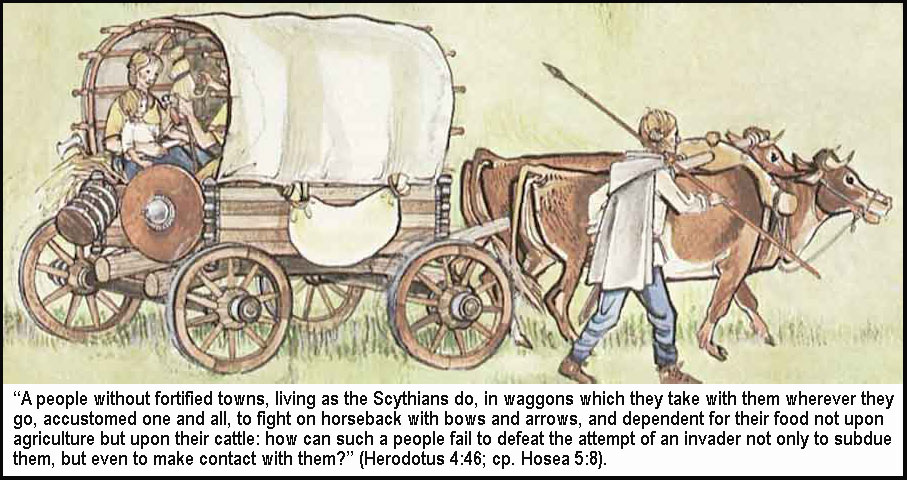 |
|
A Scythian Wagon Heading West |
The Anglo Saxon Chronicle (891 A.D.) begins by saying that the Britons came from Armenia and the Picts (of Scotland) from the south of Scythia. King Alfred said the Picts and Scots both came from Scythia. The idea that the Scots came from Scythia is found in the History of the Britons (Nennius) and most legendary accounts -- and also in unedited versions of the Venerable Bede who said that the Gaels who invaded Scotland from Ireland came originally from Scythia and the Cimmerian Chersonesus (Crimea).
The Cimmerians were a Scythian
tribe [47]. Ireland
was known as Scotia at first. Settlements were made to the bigger island until,
by about 500 A.D., a separate nation of Scotland came into being. For a time,
Ireland was called Scotia Major and Scotland Scotia Minor. It is interesting
that the Highland Scots won't eat pork.
The Scottish Declaration of Independence is an ancient document in the Register
House of Edinburgh, which states that the Scots (Lowlanders) came from Scythia
via the Mediterranean Sea, sojourned in Spain, then came to Scotland 1,200 years
after the deportation of Israel (478 A.D.).
"We know and from the chronicles and books of the ancients, we find that among other famous nations our own, the Scots has been graced with widespread renown. They journeyed from Greater Scythia by way of the Tyrrhenian [Mediterranean] Sea and the Pillars of Hercules [Straits of Gibraltar], and dwelt for a long course of time in Spain among the most savage tribes…Thence they came, twelve hundred years after the people of Israel crossed the Red Sea, to their home in the west where they still live today."
Scandinavia was anciently called SCATHanavia. The Scythians were originally called Arami [48]. Sharon Turner in History of the Anglo-Saxons (1799-1805), wrote,
"The first appearance of the Scythian tribes in Europe may be placed, according to Strabo and Homer, about the eighth, or according to Herodotus, in the seventh century, before the Christian Era. The first scenes of their civil existence...were in Asia, to the east of the Araxes."
Nennius' History of the Britons tells us that Saxons came from Germany which was known as Scythia (paragraphs 31, 37 and 50). Diodorus Siculus repeatedly calls all Germany by the name of Scythia [49]. Strabo says, "All the nations toward the northern parts, the ancient Greek writers call Scythians, and Celto-Scythians [50]." As Xenophen said, "In Europe the Scythians bear sway [51]." Pliny [52] says the Prussian coast "lay opposite to Scythia, distant a day or two's sail." Lempriere's Classical Dictionary defines "Scythia" as "Tartary, Russia in Asia, Siberia, Ukraine, the Crimea, Poland, part of Hungary, Lithuania, the northern parts of Germany, Sweden, Norway etcetera (p. 568)."
Scythians migrated all the way from Palestine to the Crimea and then to Germany and ultimately to England and Scotland. "For lo, I will command, and I will sift the House of Israel among ALL the NATIONS, like as corn is sifted in a sieve, yet shall not the least grain fall upon the earth [53]."
Did Albion Come from Albania?
We know the Israelites were taken captive to Media. Just north of the Caucasus Mountains, the Caspian shore was anciently called ALBANIA [54]. Solinus 20 says they have blue eyes. This was no doubt an Israelite location. Apparently the inhabitants next migrated to Albania in south-east Europe and then to Albion [55] -- later known as Britain. Himilco, 400 B.C., speaks of the British Isles as the lands of the Hiberni and the Albioni. The Scots called themselves Albanians.
Are BAGPIPES mentioned in the Bible?
In 2 Chronicles 5:12 several musical instruments are mentioned: 1. cymbals, 2. psalteries, and 3. harps. We know what cymbals and harps are. But what are PSALTERIES? Strong's Concordance gives the number 5035 for psaltery. The definition is: "nebel; a SKIN-BAG for liquids (from collapsing when empty); hence, a vase (as similar in shape when full); also a lyre (as having a body of like form):-- bottle, pitcher, psaltery, vessel, viol." What musical instrument is made of a SKIN BAG that COLLAPSES when empty? Only a BAGPIPE, which collapses when the air is let out.
"It is impossible to say positively with what instrument the nebel of the Hebrew exactly corresponded. From the fact that nebel in Hebrew also signifies a wine bottle or skin, it has been conjectured that the term when applied to a musical instrument denotes a kind of BAGPIPE [56]."
In I Chronicles 15:20 the Levites were commanded to "play with Psalteries on
Alamoth." The term alamoth means soprano or falsetto. The
bagpipe emits a high-pitched falsetto sound. This is not a description of a
guitar. King David danced a "Highland fling" as he brought the ark to Jerusalem
[57]. Psalteries also had fir wood components [57]. Bagpipes are
played mainly in Scotland. Is there some ancestral connection between
the Scots and ancient Israel?
Notice this definition, from The New Bible Dictionary, of the word
dulcimer
found in Daniel 3:5, "It is now generally supposed to have been a form of
bagpipe." The Scottish bagpipe has left a musical footprint wherever the Scots
have traveled from Israel to Assyria. Then to the Caucasus Mountains and the
Black Sea, to Spain, to Ireland and finally Scotland.
The Thistle of Lebanon
Both the national emblem and deemed the Flower of Scotland, the Scottish Thistle has long been beloved by the Scottish people. In the language of flowers the thistle is an ancient Celtic symbol of nobility of character as well as of birth.
The Scottish thistle is a resilient little weed that has always bloomed across Scotland's landscape, but it wasn't until the 13th century that it's place in the country's symbolism and written history was established.
The "Thistle" has, for many centuries, been a Royal Symbol associated with the Kings of Scotland. The whole modern period of The Most Ancient and Most Noble Order of the Thistle (the Scottish order of knighthood) dates from King James VII of Scotland (James II of England), who revived it in 1687, and Queen Ann, who revived it again in 1703. As with many orders of chivalry, its origins go back much further in time. Some legends relate that King Achaius founded the Order in 809 to commemorate an alliance with Emperor Charlemagne. There is some credibility to this story given the fact that Charlemagne did employ Scottish bodyguards. The foundation of this Order has been variously attributed to King David I of Scots in the 12th century, whilst later King James III created an order of knighthood using the thistle as a royal emblem.
The Thistle emblem was first shown on silver coins dated 1474 during his reign. There are indications that it had been used as the personal badge of the Scottish sovereigns during previous reigns. It seems that ever since that time the "thistle" has become uniquely associated with the Royal House of Stewart. As is the case with many other royal emblems, most authorities of heraldry are at a loss to explain the origin of the thistle as the preeminent heraldic device for Scotland.
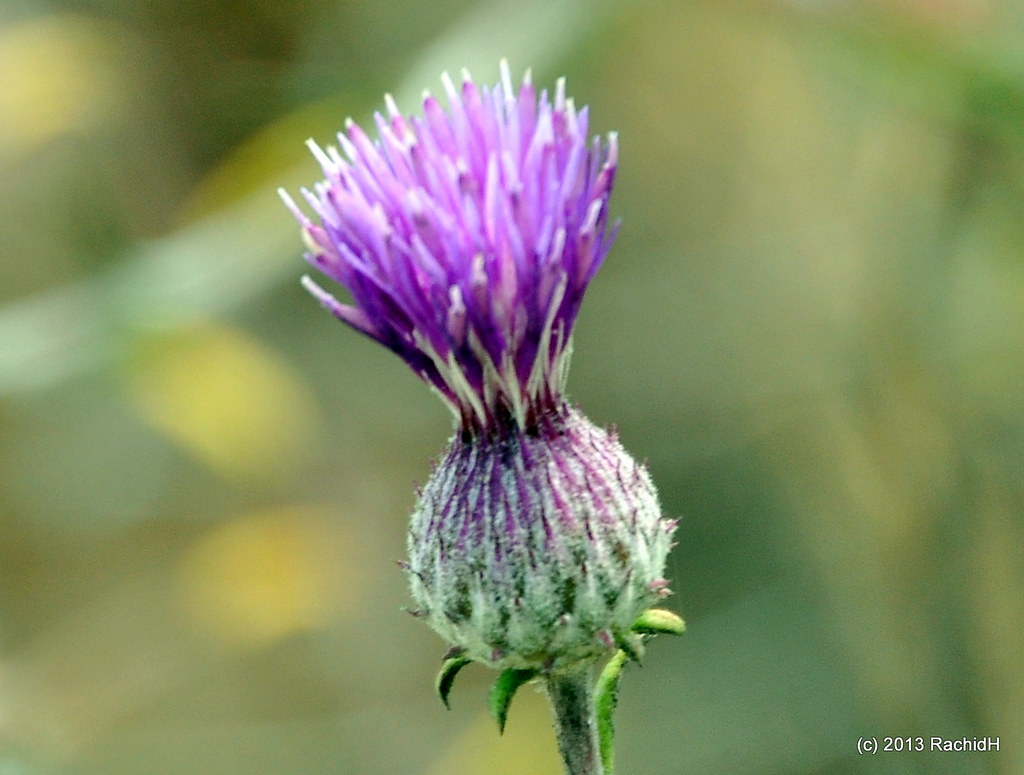 The Thistle of Lebanon |
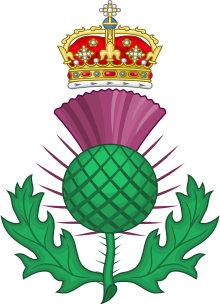 |
|
The thistle
that was in Lebanon |
The Thistle -- Symbol of |
One of the best-known thistle legends takes place in the mid 13th century during a surprise invasion by the soldiers of the Norse king, Haakon, at Largs (one of western Scotland's coastal towns). The story has it that after coming ashore, this Viking force planned to creep up on the Scottish Clansmen and Highlanders and overcome them while they slept. This amount of stealth required that they go barefoot -- which proved to be their undoing. Unfortunately for these unwary invaders, one of their soldiers bare feet came down hard on a Scottish thistle and his cries of shock and pain were enough to wake the sleeping Scots. Leaping to their feet, the clansmen charged into battle and the rest, as they say, is history... and yes, the fiery Scots were victorious!
Legend has it that because of the heroic role the plant played in the outcome of the battle, the thistle was immediately chosen as a national emblem. Now, how much of this is truth no-one knows, but we do know that by the 15th century the Scottish thistle was being used as a national emblem. It appears on silver coins that were issued in 1470 during the reign of King James III (1466-1488), and early in the 16th century it became an integral part of Scotland's' Coat of Arms. In 1503, the marriage of King James IV of Scotland to Princess Margaret Tudor of England, seems to have been the inspiration behind the poem entitled The Thrissil and The Rois (The Thistle and The Rose) penned by the Scottish poet William Dunbar. The thistle represented King James and the rose represented Princess Margaret.
Membership of the Order established in 1687 comprised the Scottish sovereign and eight knights. Queen Anne subsequently increased the number of knights to twelve, and in 1827 the number was raised to 16, which is the current number. The Orders primary emblem is the thistle, the national flower of Scotland. The motto of the Order is: Nemo me impune lacessit, which means No one provokes me with impunity. It is also the motto of all Scottish regiments, although more popularly rendered as: Wha daur meddle wi me?
Historians and expert researchers in heraldry have, to date, not been able to come up with a definitive answer as the actual origins of this thistle emblem in the royal history of Scotland. They simply have not been able to pin it down. Why the thistle, a plant many associate with a weed? Why create an Order of Chivalry around this weed and appoint knights to it? Why is this humble thistle associated with royalty? You even find it represented not only in the Royal Arms of Scotland but also in the Royal Coat-of-Arms of the United Kingdom.
Once again, it is only when we turn to the Bible that we discover the answer to the mystery. Israel’s history book (the Bible) records furious animosity between King Amaziah of Judah and King Joash of the Northern Kingdom of Israel in which the King of Judah challenges the King of Israel to battle. King Joash responds by sending Amaziah, the King of Judah, a sarcastic and most arrogant reply in which he refers to himself rather arrogantly as a Cedar of Lebanon (the king of all trees), whilst at the same time referring to the King of Judah as a "Thistle." He goes on to say that a wild beast is going to trample the "Thistle" [58].
Subsequently, in the inevitable battle that ensued, Amaziah, the King of Judah was taken captive and his armies suffered a terrible defeat at the hands of Israel. His enemy King Joash, King of Israel, broke down the walls of Jerusalem and took all the articles of silver and gold from the Temple and the King’s treasuries in Jerusalem. Somehow, from that time forth, the epithet given to the King of Judah has stuck for evermore and it has thus ended up in Scotland. The likelihood, therefore, is very high that the origin of the Royal Thistle of Scotland may well have been derived from the above incident. It seems that ever since that time the kings of Judah ended up with a new nick-name and it appears they turned the thistle epithet, which was meant as an insult, into a badge of pride instead.
Thistles are very abundant in Palestine, some even attaining the height of 5 or 6 feet. Between Nazareth and Tiberius one author was amazed to see the earth covered with immense tracts of these plants. Another author reported that the thistles of Palestine rivaled those of his native Scotland!
The historians and researchers specializing in this area of heraldry accept that many Scottish orders of chivalry have their origins much further back, and are frequently shrouded in the mists of time. Might we thus, in this Royal Thistle emblem, find an indication that the kings of Scotland are descended from that same illustrious Davidic line of the kings of Judah? Yes, indeed -- the evidence is overwhelming! Aside from scores of books and articles, there are quite a few people of other backgrounds with some knowledge of the subject who would certainly say so. This is certainly the case with the Court of the Lord Lyon, the official heraldic authority for Scotland. The origin of the office goes way back in history. The Lord Lyon is a great officer of State, who acts as heraldic adviser to the Sovereign, and in his judicial role, he decides on questions of succession and registers pedigrees.
Today the Thistle is seen on everything from sporrans and jewelry to soap and tea-towels, and it's a Scottish symbol recognized all over the world.
Uniting the Stick (Scepter) of Judah and the Stick (Scepter) of Israel
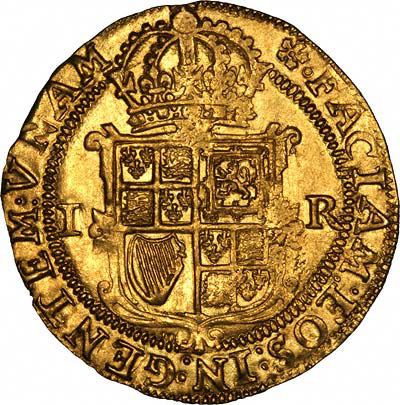 |
|
The "Unite" of King James VI |
In 1603 King James VI of Scotland became King James I of England as well. He united the two into one. King James VI of Scotland claimed the LORD made him king over Israel. He struck a gold coin called the Jacobus and had it inscribed in Latin with the prophecy of Ezekiel 37:22: Faciam Eos in Gentem Unam, which translates from Latin to English as I will make them one nation. The coin was called the "Unite" (see above). The first Union Jack was formed in 1606, then in 1801 the cross of St. Patrick was sandwiched in between the flags of Scotland and England. This Union of Jacob or Union Jack was the result of the progressive merging of the inhabitants of the British Isles. Then later they became a multitude of nations [59] or aka fullness of gentiles [60]
The Scottish Declaration of Independence
The Scottish Declaration of Independence, a prized document attested by Robert the Bruce's barons in the assembled Parliament, dated A.D.1320, asserts that the Scottish nation -- with a list of one hundred and thirteen monarchs -- migrated to the British Isles from Scythia by way of Spain. The document emphasizes an Israelite context -- specifically that the migration occurred 1200 years after the outgoing of Israel (from Egypt). This would indicate a period of the 3rd-2nd centuries B.C.
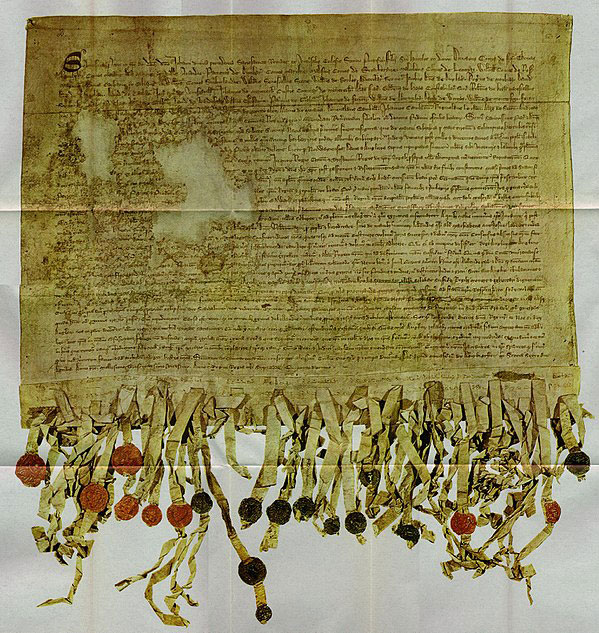 |
|
The Scottish Declaration of
|
Notice, now, some of the similarities between the Israelites and the Scythians:
Israelites, Scythians, and Saxons Without A King
The following facts connect both Saxons and Scythians with Israel. Israel was to be many days without a king [61] "The most ancient account of the Saxon government on the continent exists in this short but expressive passage of Bede (672 A.D. - 735):
"The ancient Saxons have no king but many chiefs set over their people, who, when war presses, draw lots equally, and whomsoever the chance points out, they all follow as leader, and obey during the war. The war concluded, all the chiefs become again of equal power [62]."
In the Lindenb. Gloss. 1347, the following occurs: "TWELVE Ethelings governed over the land of the Saxons; and whenever war arose in that land, the Saxons chose one of the TWELVE to be king while the war lasted; when the war was finished, the TWELVE became alike [63]."
The Scythian Levites
Herodotus records that there was a special tribe among the Scythians who lived separately from the rest of the Scythians. They were called the Argippaei. They lived in a dwelling of white felt. Herodotus wrote, “No man harms these people, for they are regarded as holy, and they own no weapons of war. They judge their neighbors’ quarrels, and the fugitives who go to them for protection are left unharmed [64]." These are clearly the Priests and Levites of Israel, who were considered holy, wore white linen, and separated themselves from the rest of the Israelites and did not even fight in battle. They also often acted as judges.
Numbers 27:2: "And they stood before Moses, before Eleazar the priest, and before the leaders and all the congregation, by the doorway of the tabernacle of meeting."
I Chronicles 23:2: "And he gathered together all the leaders of Israel, with the priests and the Levites. 3 Now the Levites were numbered from the age of thirty years and above; and the number of individual males was thirty-eight thousand. 4 Of these, twenty-four thousand were to look after the work of the house of the LORD, six thousand were officers and judges."
A. H. L. Heeren, in his work, [116] states that,
"He [Herodotus] describes the Massagetae as a warlike people, and the Argippaei and Issedones as devoted to peaceful possessions; which would almost make us suppose that there existed distinct castes amongst these nations [Scythians]....Their [the Argippaei] territory was, therefore, a sanctuary....The name of holy people which was given them, shows plainly that there was a religious character attached to them..."
The Druids are likely descended from these same Levite priests, wearing robes of white.
Israelites, Scythians and Saxons Had Divining Rods
The Saxon custom of divining by rods or augury by wands [65] can be traced to the Israelite practice mentioned in Hosea 4:12 which says, "My people ask counsel of their stocks, and their staff declareth unto them." Notice what Tacitus says: "They cut a small branch of a fruit-tree into twigs, marked them, and scattered them at random on a white vest. The priest, if it were a public COUNCIL, or the father, at a private CONSULTATION, prayed, gazed at heaven, drew each three times, and interpreted according to the mark previously impressed."
King Alfred the Great (King of Wessex, 871-c.886; King of the Anglo-Saxons, 886-899) also says they cast lots with twigs [66]. Herodotus says, "Scythia has an abundance of soothsayers who foretell the future by means of a number of willow wands. A large bundle of these wands is brought and laid on the ground. The soothsayer unties the bundle, and places each wand by itself, at the same time uttering his prophecy" [67].
Israelites, Scythians and Saxons Had Similar Religions
The religion of Odin included the belief in a beneficent ALL-FATHER in heaven, who made the heaven, and earth, and air out of nothing; in the future purifying the world by fire, a catastrophe connected with the embodiment of evil., who is frequently described as a serpent or a dragon; in a New World that is to come, and in the advent of "the POWERFUL ONE" for judgment.
Israelites and Scythians Had Groves But No Images
A German (Scythian) custom mentioned in Tacitus' Germania 9:10 that seems to be Israelite is as follows:
"The deities of the Germans are NOT confined within walls, nor fashioned into any mortal shapes; they hallow groves and woods, and call by the name of gods that hidden presence which is felt by reverence alone."
Many passages in the Bible mention groves as places of Israelite worship [68] and the biblical command to "not make unto thee any graven image or any likeness of anything" is also well known. Immediately before the captivity, "Ephraim was joined to idols," but neither in Scythia nor in Germany did they have images so they must have repented somewhat. Neither did they have kings for "the children of Israel shall abide many days without a king, and without a prince, and without a sacrifice, and without an image, and without an ephod, and without teraphim" [69]. Scythians made no idols [70] except in the worship of Mars which was probably mere scimitar-worship that may be alluded to sarcastically in Ezekiel 21:9-10.
Herodotus records that the Scythians were very zealous in forbidding idolatry and the worship of foreign gods. In one instance, King Saulius of Scythia executed his own brother for participating in the rites of a Greek mother-goddess festival and wearing images associated with the mother-goddess [71]. In another instance, a Scythian king (Scyles) participated in forbidden, pagan rituals of the Greeks in which devotees allowed Bacchus to possess them in frenzied rites. King Scyles tried to prevent any Scythian from learning about his secret life. His actions were discovered; however, and the Scythians rejected him as king, selecting his brother, Octamasades, as the new king. With an army, Octamasades pursed his paganized brother, and beheaded him in Thrace (the modern Balkan region of Europe), where Scyles had sought refuge [72].
The fact that the Scythians executed, without mercy, even their own rulers and royalty who worshipped pagan gods or who kept images of them and that they avoided swine’s flesh shows that they were practicing two features of the Law of YEHOVAH God given to the Israelites under Moses. They evidently had experienced a revival in their new homeland near the Black Sea.
Israelites-Scythians-Saxons Were Civilized, Wise and Unconquerable
"Round the Black Sea...are to be found, if we except Scythia, the most uncivilized nations in the world. No one could claim that the rest have any of the arts of civilized life, or have produced any man of distinction" [73]. Aeschylus says "The Sacae [or Scuths] were noted for their good laws, and were preeminently a righteous people." Colossians 3:11 contrasts Barbarians with Scythians. Thucydides says, "In respect of military strength and number of soldiers, NO single nation, either in Europe or Asia, could match the Scuths [74]."
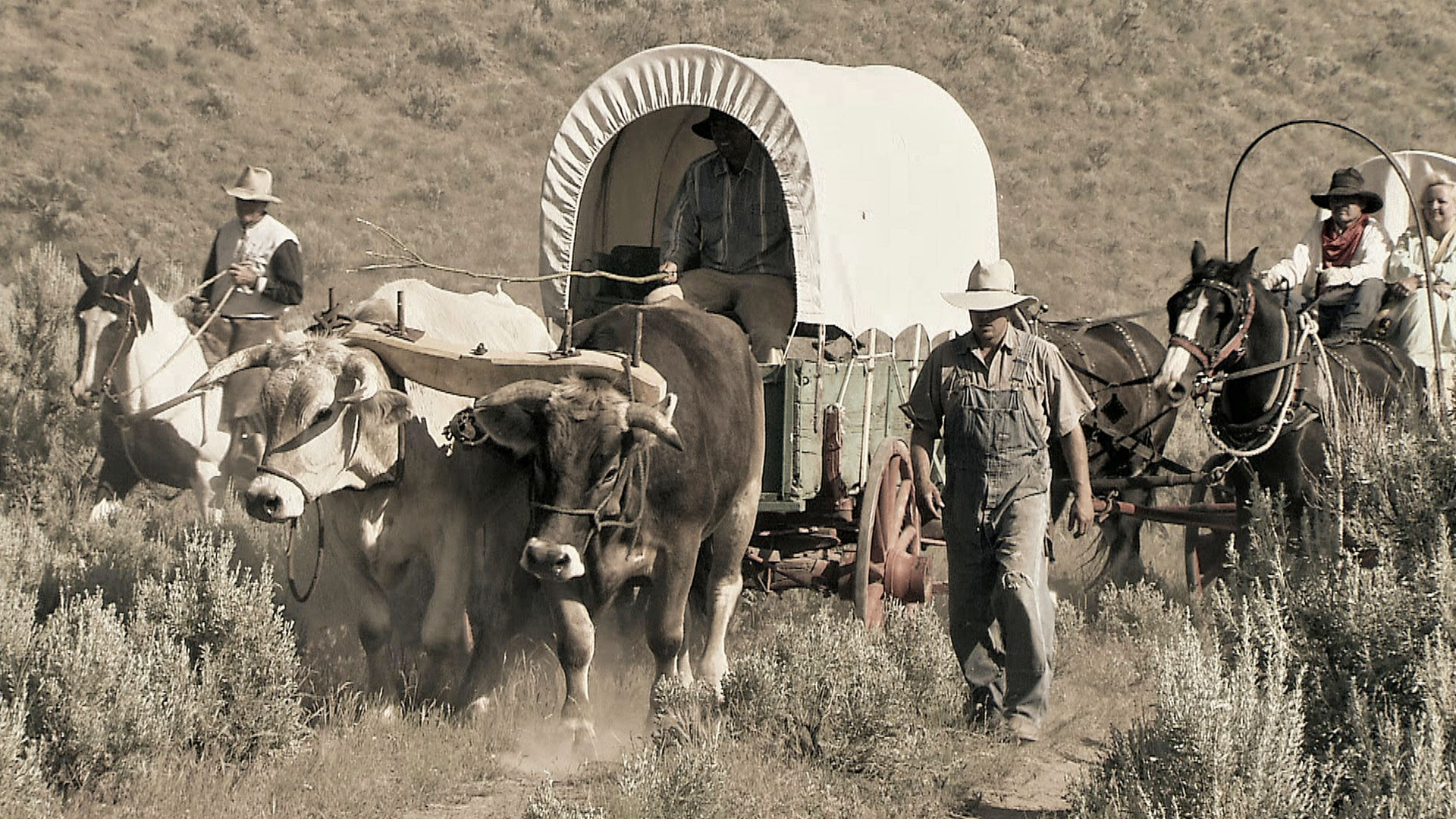 |
|
A Wagon Heading West -- America in the 1800s |
As Psalm 105:24 says, "He [YEHOVAH God] INCREASED His people Israel greatly, and made them STRONGER than their enemies."
Herodotus adds, "They have, in one respect...shown themselves wiser than any other nation upon the face of the earth....Possessing no houses but wagons, and carrying these about wherever they go, accustomed, one and all, to fight on horseback with bows and arrows, and dependent for their food not upon agriculture but upon their cattle: how can they fail of being UNCONQUERABLE, and even UNASSAILABLE [75]?"
"No weapon that is formed against thee shall prosper [76]."
Their oaths were accompanied by ceremonies identical with those of the Medes; they used skulls as drinking cups, like the Northmen of later years; their weapons were the spear, the battleaxe and the bow; they made booths like the Israelites; they had fables of griffins, the representations of which on the Scythian tombs are almost exactly like the winged lions of the Assyrians.
Israelites and Scythians Boiled Meat By Burning Bones
Describing their sacrifices, Herodotus says, "After flaying the beasts, they take out all the bones, and put the flesh into boilers or cauldrons of a large size, then placing the bones of the animals beneath the cauldron, they set them alight, and so boil the meat [77]." In Ezekiel 24:5 we read, "take the choice of the flock, and burn also the bones under it, and make it boil well." Professor Rawlinson thinks both these passages refer to the same custom.
Israelites and Scythians Didn't Eat Pigs
Finally Herodotus says regarding sacrifices, "They never use swine; nor, indeed, is it their wont to breed them in any part of their country [78]." Yes "the swine...is unclean to you" [79]. Strabo says of the Dacians "that the care of worshipping the Supreme Being is GREAT among this nation, is not to be doubted, after what Posidonius has related, 'and they even abstain from animal food from religious motives,' as likewise on account of the testimony of other historians [80]."
Since the Scythians not only refused to allow pigs to be used in sacrificial purposes, but also banned them entirely from their territory, it is evident that the Scythians did not eat the flesh of swine either. This avoidance of swine's flesh is a characteristic Torah-based, Israelite dietary trait. Secular reports that the Black Sea Scythians avoided the use of swine for any purpose substantiates Jeremiah 3:11's record wherein YEHOVAH God stated: "...backsliding Israel hath justified herself more than treacherous Judah."
Israelites and Scythians Both Without Flax
Herodotus says,
"Hemp groweth abundantly in this land of Scythia, and of this the people make garments that are very like to garments made of flax. These people possess neither houses, cities, nor cultivated land: but lived in wagons and on the produce of their cattle" [81].
This reminds us of Hosea 2:2-14 which says,
"Plead with your mother, plead...Lest I strip her naked, and set her as in the day that she was born, and make her as a wilderness, and set her like a dry land, and slay her with thirst...For she said, I will go after my lovers, that give me my bread and water, my wool and my flax, mine oil and my drink...For she did not know that I gave her corn, and wine and oil, and multiplied her silver and gold, which they prepared for Baal. Therefore will I return, and take away my corn in the time thereof, and My wine in the season thereof, and will RECOVER my wool and MY FLAX given to cover her nakedness."
Israelites-Scythians Dwell Among Graves and Create High Mounds
Israel dwelt among the monuments -- the barrows and mounds of Southern Russia, the caves in which the Getae lived in memory of that to which Zalmoxis retired -- and ate unclean food. Therefore Isaiah 65:4 says Israelites "remain among the graves, and lodge in the monuments; that eat swine's flesh, and broth of abominable things is in their vessels." Pliny, Natural History 4:12 calls them "cave-dwellers." "Set thee up waymarks, make thee high mounds [82]." "They [Scythians] set to work, and raise a vast mound above the grave all of them vying with each other, and seeking to make it as tall as possible [83]."
Israelites And Scythians Both Had a Drinking Problem
Drunkenness was prevalent among Israelites [84]. "Woe to the...drunkards of Ephraim [85]." "Howl all ye drinkers of wine [86]." "Woe to them that rise up early in the morning, that they may follow strong drink; that continue until night, till wine inflame them [87]." When the Spartans wanted to drink a purer wine than normal, they gave the order to fill Scythian fashion [88]." The Scythians were driven out of Media by being invited to a feast and made drunk and then murdered [89].
Many of the customs of the Scythians struck the Greeks as bizarre. For example, Herodotus [90] reports that the Scythians drank their wine neat, that is, undiluted with water, contrary to the custom among the Greeks, who diluted their wine with water in large kraters. According to Athenaeus [91], “the Scythians are in the habit of drinking to great excess” and “to get drunk is to behave like a Scythian.”
Israel and Scythia Didn't Intermarry with Other Nations
Tacitus says the Kimbri were Germans and "the Germans never to have intermarried with other nations; but to be a Race, Pure, Unmixed, and stamped with a distinct character. Hence a family likeness pervades the whole though their numbers are so great [92]." Thus was Israel sifted through a sieve, but not one grain was allowed to fall to the ground (53). "Scythians are dead-set against foreign ways [93]." Their destiny was to "DWELL ALONE [94]."
We find, in the Bible, the prohibition of intermarrying refers to all the non-Israelite nations -- notice Nehemiah 13:3, 23, 25-27:
"As soon as the people had heard the Law, they excluded all of foreign descent from Israel…At that time I again saw Jews [Judahites] who had married women from Ashdod, Ammon and Moab. As regards their children, half of them spoke the language of Ashdod or the language of one of the other peoples, but could not speak the language of Judah. I reprimanded them and called down curses on them; I struck several of them and tore out their hair and made them swear by God, 'You shall not give your daughters to their sons or take their daughters either for your sons or for yourselves…Must we then hear it said that you too are committing this grave crime: playing traitor to our God by marrying foreign women? [95]."
Geographical Landmarks
The Rivers emptying into the Black Sea formerly had names such as the Ister, Tyras, Borysthenes, and Tanais. After the Scythians entered that region, these rivers were given new Israelite names based on the name of the Israelite tribe of Dan. The new names of these rivers were the Danube, the Dniester, the Dnieper and the Don.
The Israelite tribe of Dan had a tendency to re-name geographical locations after its own tribal name [96]. Collier's Encyclopedia confirms there is no doubt the Scythians gave these rivers their modern names. It states: "The names of the... rivers Danube, Dnestr, Dnepr and Don are Scythian..." These rivers are known by these Scythian names to this day on modern maps, and all these Scythian names are based on the Israelite tribe of Dan.
Scythian Artwork Reveals Them to Be Semites
It is assumed by some that the Scythians migrated into the Black Sea region from Central Asia. Historical evidence easily shows this assumption is patently false. The Scythians were famous in the ancient world for their magnificent gold artwork. If the Scythians originated in Central Asia, their self-portrayals should show Scythians with Mongol or Oriental faces. This is definitely not the case!
On their gold artwork, the Scythians uniformly depict themselves as Semites who are often bearded. Illustrations of Scythians in the encyclopedias [117] uniformly depict Scythian men, women and youth as Caucasian (or Semitic) individuals.
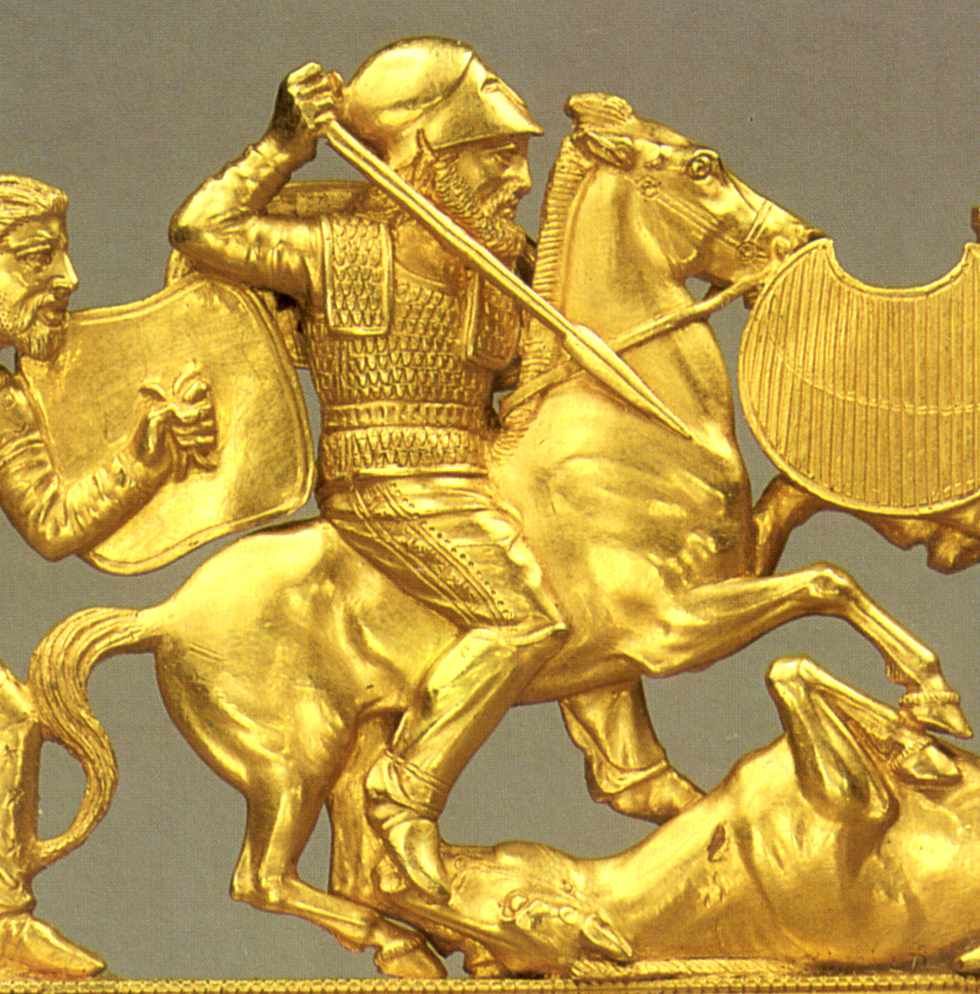 |
Georges Charriere, author of the book, Scythian Art: Crafts of the Eurasian Nomads, makes this observation about the skilled artwork of the Scythians:
"There is no ground for concluding that this style of art had its birth in the Altai or in any other region of Siberia. Along with the other elements of Scythian culture, it...originated in the peripheral regions of Assyria, among the Iranian-language tribes settled in the north of Iran" (emphasis added).
This is an important observation! It has long been known that many of the Israelites went into captivity into Assyrian regions or the Medo-Persian region of Iran [97]. Charriere notes that the Scythian artwork (and "other elements of Scythian culture") had its origin in the very regions into which the captive Israelites were first placed.
Therefore, the Scythian artwork, their physical appearances and other aspects of their culture show that the Scythians migrated to their Black Sea/Russian steppe regions from the south -- NOT from the more northern recesses of Central Asia or Siberia.
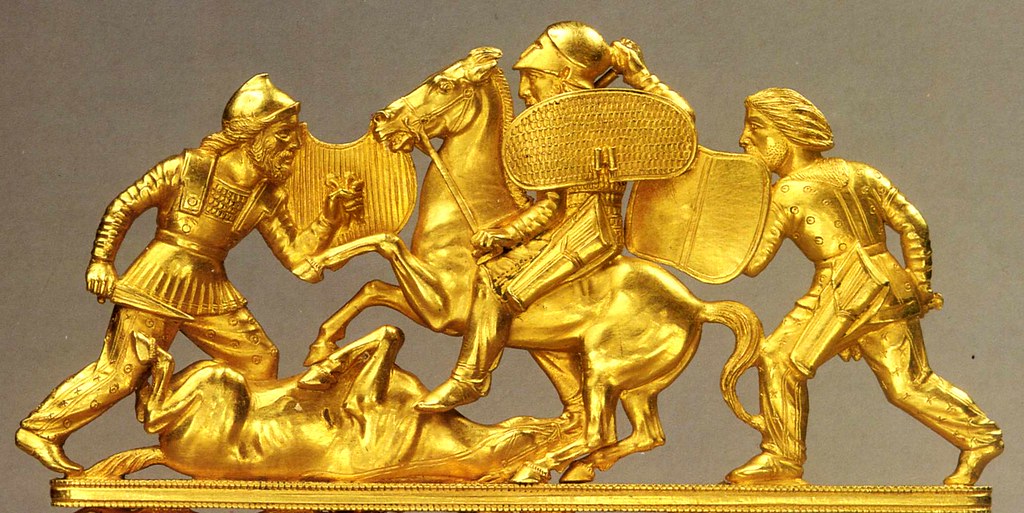 |
The Scythians were hardly wild barbarians from Central Asia. Like the Israelites of old, they were skilled agriculturalists who not only tended herds and flocks of livestock, but also grew crops. Indeed, they were grain exporters to other peoples in the ancient world. The Scythians exported 600,000 bushels of grain to Athens on an annual basis just decades after the time of Herodotus. Wild barbarians from the interior of Asia would hardly cultivate and harvest row crops, negotiate and fulfill international trade contracts, etc. The Scythians were quite a civilized people.
Israelites and Scythians Were Known As Arians
Ezekiel 1:1 mentions the River Chebar (Habor) where Judahites were taken captive in Babylon. But Reuben, Gad and half-Manasseh were placed by Tiglath-Pileser in the mountain district of Great Media, a region expressly called HARA [98]. In fact all ten tribes of Israel were placed in the "cities of the Medes [99]." Herodotus, in The Histories [100], says, "The Medes were once universally known as ARIANS." HARA was named ARIA, ARIANA and ARACHOSIA by the Greeks (see Ptolemy). It contains the city of HARAT. According to the black obelisk discovered in the ruins of the palace of Nimrod which is now in the British Museum, the people or leader of the Arians was called ESAKSKA (Isaac) and their principal cities were "Beth-Telabon, Beth-Everak and Beth-Tsida" in 670 B.C.
This information connects the Israelites with the Arians. Also the Arian language is Hebraic, and like Hebrew, has three sibilants [101]. Diodorus Siculus says,
"many conquered peoples were removed to other homes, and two of these became very great colonies: the one was composed of Assyrians and was removed to the land between Paphlagonia and Pontus, and the other was drawn from Media and planted along the Tanais (the River Don in ancient Scythia -- the modern Ukraine, north of the Black Sea, in southern Russia) [102]."
Notice the areas from which these colonies came -- Assyria and Media. The very areas to which the House of Israel was taken captive! "So was Israel carried away out of their own land TO ASSYRIA unto this day [103]." "The king of Assyria took Samaria, and carried Israel away INTO ASSYRIA and placed them in Halah and in Habor by the River of Gozan, and in the CITIES OF THE MEDES [104]."
These Arians must have migrated to Thrace because, according to Stephanus of Byzantium [105], Thrace was called ARIA. Herodotus also mentions a people "north of Thrace" "who dress in the Median fashion" and "claim to be colonists from Media [106]."
From Thrace they migrated to Germany since Tacitus mentions the HARII there in south-east Germany [107]. The Thracian Scythians pricked and stained their bodies [108]; so did the ARII of Germany (Tacitus); the BELGAE of Britain [109], and the PIKS of Norway and Scotland. We believe that ARIANS or Nordic peoples are found primarily in north-west Europe today. Their mission is to bless all nations of the earth [110]. Rawlinson [111] says, "that the Medes were a branch of the great ARIAN family, closely allied both in language and religion to the Persians [Keturah's descendants?], another Arian tribe, seems now to be generally admitted....Darius Hystaspes, in the inscription upon his tomb, declares himself to be a Persian, the son of a Persian, an Arian of Arian descent [112]."
According to Herodotus [113], the Magi lived next to the Budii in MEDIA. Daniel was made Rab-Mag by Nebuchadnezzar [114]. The name Mag in Pehlvi (the language of Persia during the age of the Sassanidae, 224 A.D. - 651) denotes Priest. The Magi of MEDIA visited the child Messiah [115] because they were Israelites.
Footnotes:
[1] Genesis 33:17
[2] Exodus 12:37
[3] Joshua 13:27
[4] Herodotus, Melp.
5, 7, 6, 11
[5] Gawler's Our Scythian Ancestors Identified with Israel,
p. 9
[6] Werner Keller, The Bible As History,
p. 246
[7] Pliny, Natural History
4:12
[8] De reb. Get. 24
[9] 2 Kings 18:11
[10] Diodorus Siculus, 2:3
[11] Herodotus, The
Histories 4:11
[12] Herodotus, The Histories
Book 4
[13] Nennius' History of the Britons 31,
37 and 50
[14] Strabo, 2:11
[15] Encyclopedia
Britannica, article: "Scythia", 11th ed.
[16] Herodotus, The Histories,
7:64
[17] 2 Kings 17:23
[18] Genesis 48:16
[19] 2 Kings 18:11
[20] 1 Chronicles 5:26
[21] Ptolemy, 6:7
[22] Ptolemy, 6:14
[23] Diodorus Siculus,
2:3
[24] 1 Chronicles 5:26; 2
Kings 18:11
[25] Jeremiah 3:12
[26] Encyclopedia Britannica
2:857, 1943
[27] Herodotus,
The Histories
1:104-105
[28] 2 Chronicles 34-35
[29] Keller, The
Bible as History, p. 273
[30] 2 Kings 23:22; 2
Chronicles 35:18
[31] Herodotus, The Histories
4:1
[32] Herodotus, The
Histories 1:201, 209, 216; 4:11
[33] Herodotus, The Histories
4:11
[34] Herodotus,
The Histories 4:5
[35] Herodotus, The Histories
1:201-215
[36] Diodorus Siculus,
p. 127
[37] Diodorus
Siculus, p.127
[38] Herodotus, The Histories
4
[39] Rice, The Scythians,
p. 45
[40] Encyclopedia Britannica
17:566, art. "Persia"
[41] Herodotus, The Histories
4:1 and 4
[42] Herodotus, The
Histories 4:59
[43] Herodotus, The
Histories 4:63
[44] Herodotus, The
Histories 4:76
[45] Herodotus, The
Histories 4:46
[46] Diodorus
Siculus 2:3
[47] Encyclopedia Britannica
2:857
[48] Pliny, Natural History
6:19
[49] Diodorus Siculus,
5:355
[50] Strabo,
11:507
[51] Xenophen,
11:507
[52] Pliny, Natural
History 4:13
[53] Amos 9:9
[54] Strabo's map, 25
A.D.
[55] Ptolemy's map, 160
A.D.
[56] Peloubet's Bible Dictionary
[57] 2 Samuel 6:5
[58] 2 Chronicles 25:18
and 2 Kings 14:9
[59] Genesis 48:19
[60] Romans 11:25
[61] Hosea 3:4
[62] Ecclesiastical History of the English People
[63] Sharon Turner's
History of the Anglo-Saxons 1:20
[64] Herodotus, The Histories
4:23
[65] Tacitus'
Germania
9:10
[66] Sharon Turner's History of the Anglo Saxons
1:223
[67] Herodotus, The
Histories 4:67
[68] 1 Kings 14:15
[69] Hosea 3:4
[70] Herodotus,
The Histories 4:59
[71] Herodotus, The
Histories 4:76
[72] Ibid.,
4:78-80
[73] Herodotus,
The Histories
4:46
[74] Thucydides
2:97 spoken about 420 B.C.
[75] Herodotus, The Histories
4:46
[76] Isaiah 54:17
[77] Herodotus, The Histories
4:61
[78] Herodotus,
The Histories 4:63
[79] Leviticus 11:7
[80] Strabo 7:3:4
[81] Herodotus, The Histories
4
[82] Jeremiah 31:21
[83] Herodotus,
The Histories
4:71
[84] Deuteronomy 21:20-21
[85] Isaiah 28:1-3
[86] Joel 1:5
[87] Isaiah 6:11-13
[88] Herodotus, The Histories
6:84
[89] Herodotus,
The Histories 1:106
[90] Herodotus, The
Histories 4:84
[91] Athenaeus, Deipnosophistae 11.499
[92] Tacitus de Morib. Ger.
c.v.
[93] Herodotus, The Histories
4:75
[94] Numbers 23:9
[95] The Jerusalem Bible
[96] Joshua 19:47
[97] II Kings 15:29,
18:11
[98] 1 Chronicles 5:26;
Ar being a mountain
[99] 2 Kings 17:6
[100] Herodotus, The Histories 7:62
[101] Moore, Lost Tribes,
pp. 288-290, 299
[102] Diodorus Siculus,
2:43
[103] 2 Kings 17:23
[104] 2 Kings 17:6
[105] Stephanus of
Byzantium, Ethnica
[106] Herodotus, The Histories
5:9
[107] Tacitus, Ger. 43
[108] Herodotus, The Histories
5
[109] Julius Caesar,
de Bell. Gall.
[110] Genesis 22:18;
Micah 5:7
[111] in "Herodotus", Essay
iii, p. 325
[112] p. 77, Who Are We?
by Harrison
[113] Herodotus, The
Histories 1:110
[114] Daniel 2:48
[115] Matthew 2:1-2
|
Hope of Israel Ministries -- Correcting the Errors of Modern "Christianity"! |
|
Hope of Israel
Ministries |
 |
Scan with your Smartphone for more information |